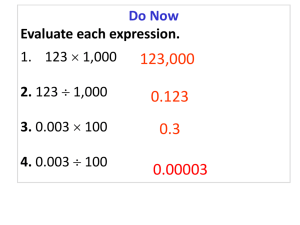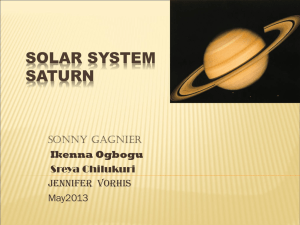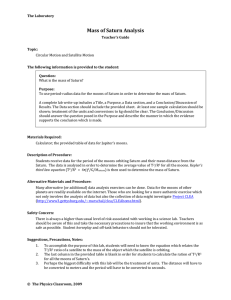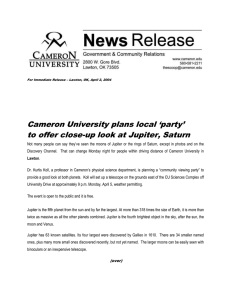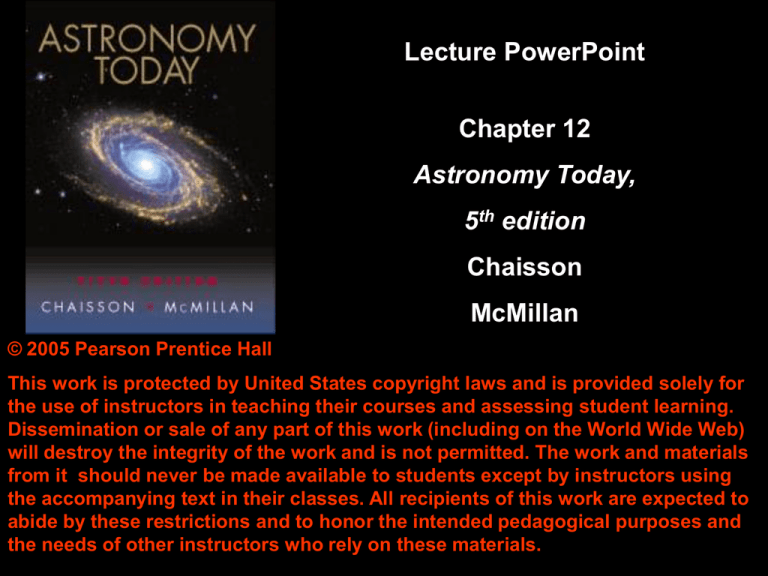
Lecture PowerPoint
Chapter 12
Astronomy Today,
5th edition
Chaisson
McMillan
© 2005 Pearson Prentice Hall
This work is protected by United States copyright laws and is provided solely for
the use of instructors in teaching their courses and assessing student learning.
Dissemination or sale of any part of this work (including on the World Wide Web)
will destroy the integrity of the work and is not permitted. The work and materials
from it should never be made available to students except by instructors using
the accompanying text in their classes. All recipients of this work are expected to
abide by these restrictions and to honor the intended pedagogical purposes and
the needs of other instructors who rely on these materials.
Chapter 12
Saturn
Units of Chapter 12
Orbital and Physical Properties
Saturn’s Atmosphere
Saturn’s Interior and Magnetosphere
Saturn’s Spectacular Ring System
The Moons of Saturn
New Moons or Ring Debris at Saturn?
12.1 Orbital and Physical Properties
Mass: 5.7 × 1026 kg
Radius: 60,000 km
Density: 700 kg/m3 – less than water!
Rotation: rapid and differential, enough to
flatten Saturn considerably
Rings: very prominent; wide but extremely
thin
12.2 Saturn’s Atmosphere
Saturn’s atmosphere also shows zone and
band structure, but coloration is much more
subdued than Jupiter’s
Mostly molecular hydrogen, helium, methane,
and ammonia; helium fraction is much less
than on Jupiter
12.2 Saturn’s Atmosphere
Similar to Jupiter’s, except
pressure is lower
Three cloud layers
Cloud layers are thicker
than Jupiter’s; see only
top layer
12.2 Saturn’s Atmosphere
Wind patterns on
Saturn are similar to
those on Jupiter,
with zonal flow:
12.2 Saturn’s Atmosphere
Jupiter-style “spots” rare on Saturn; don’t
form often and quickly dissipate if they do
12.3 Saturn’s Interior and Magnetosphere
Interior structure similar to Jupiter’s:
12.3 Saturn’s Interior and Magnetosphere
Saturn also radiates more energy than it gets
from the Sun, but not because of cooling.
• Helium and hydrogen are not well-mixed;
helium tends to condense into droplets and then
fall
• Gravitational field compresses helium and
heats it up
12.3 Saturn’s Interior and Magnetosphere
Saturn also has a strong magnetic field, but
only 5% as strong as Jupiter’s
Creates aurorae:
12.4 Saturn’s Spectacular Ring System
Saturn has an
extraordinarily
large and complex
ring system, which
was visible even to
the first
telescopes
12.4 Saturn’s Spectacular Ring System
Ring features visible from Earth:
12.4 Saturn’s Spectacular Ring System
Ring particles range in size from fractions of a
millimeter to tens of meters
Composition: water ice – very similar to
snowballs
Why rings?
• Too close to planet for moon to form – tidal
forces would tear it apart
12.4 Saturn’s Spectacular Ring System
Closest distance that moon could survive is
called Roche limit; ring systems are all inside
this limit
12.4 Saturn’s Spectacular Ring System
Voyager probes showed Saturn’s rings to be
much more complex than originally thought
Earth is shown
on the same
scale as the
rings
12.4 Saturn’s Spectacular Ring System
Voyager also
found radial
“spikes” that
formed and then
dissipated; this
probably happens
frequently
12.4 Saturn’s Spectacular Ring System
Cassini division turns out not to be completely
empty:
It is caused
by an orbital
resonance
with other
ring particles
and Saturn’s
innermost
moon
12.4 Saturn’s Spectacular Ring System
• Other edges and divisions in rings
are also the result of resonance
• “Shepherd” moon defines outer
edge of A ring through gravitational
interactions
12.4 Saturn’s Spectacular Ring System
Strangest ring is outermost, F ring:
It appears to have
braids and kinks.
12.4 Saturn’s Spectacular Ring System
F ring’s oddities probably caused by two
shepherd moons, one of which can be seen
here:
12.4 Saturn’s Spectacular Ring System
Details of formation are unknown
• Too active to have lasted since birth of solar
system
• Either must be continually replenished, or are
the result of a catastrophic event
12.5 The Moons of Saturn
Saturn’s many moons appear to be made of
water ice
Besides the small moons, Saturn has:
Six medium-sized moons (Mimas, Enceladus,
Tethys, Dione, Rhea, and Iapetus)
One large moon (Titan) which is almost as
large as Ganymede
12.5 The Moons of Saturn: Titan
Titan has been known for many years to have an
atmosphere thicker and denser than Earth’s;
mostly nitrogen and argon
Makes surface
impossible to see; the
picture at right was
taken from only 4000 km
away:
12.5 The Moons of Saturn: Titan
Trace chemicals in
Titan’s atmosphere
make it chemically
complex
12.5 The Moons of Saturn: Titan
Due to difficulty of getting information, little is
known about either the surface or the interior
structure of Titan.
This image, taken
with an infrared
telescope, shows
some indication of
surface features:
12.5 The Moons of Saturn: The MediumSized Moons
12.5 The Moons of Saturn: The MediumSized Moons
• Mimas, Enceladus, Tethys, Dione, and
Rhea all orbit between 3 and 9
planetary radii from Saturn, and all are
tidally locked – this means they have
“leading” and “trailing” surfaces.
• Iapetus orbits 59 radii away, and is
also tidally locked.
12.5 The Moons of Saturn: The MediumSized Moons
Rhea, the largest, has a highly reflective, heavily
cratered surface:
Wispy features are
on trailing side but
not leading; origin
not yet understood:
12.5 The Moons of Saturn: The MediumSized Moons
Dione and Tethys are similar, having icy,
heavily cratered surfaces:
12.5 The Moons of Saturn: The MediumSized Moons
Mimas is the closest moon to Saturn, and
has a crater covering one-third of its
surface, the result of an impact that must
have almost destroyed the moon:
12.5 The Moons of Saturn: The MediumSized Moons
Enceladus orbits close to Mimas, but is
very shiny, indicating a surface covered
with ice crystals:
12.5 The Moons of Saturn: The MediumSized Moons
Iapetus is two-faced: its leading side is very dark
(reflects 3% of incoming light), while its trailing
side is bright (reflects 50% of incoming light).
Cause is unknown.
12.5 The Moons of Saturn: The Small
Moons
Masses of small moons not well known
Two of them share a single orbit:
12.5 The Moons of Saturn: The Small
Moons
Two more are at
the Lagrangian
points of Tethys:
12.5 The Moons of Saturn: The Small
Moons
Hyperion, orbiting between Titan and
Iapetus, is so affected by their
gravitational fields that its orbital
speed and the orientation of its axis
are constantly changing, in a neverrepeating pattern.
This tumbling is an example of chaotic
motion!
Summary of Chapter 12
• Saturn, like Jupiter, rotates differentially and is
significantly flattened
• Saturn’s weather patterns are in some ways
similar to Jupiter’s, but there are far fewer
storms
• Saturn generates its own heat through the
compression of “helium raindrops”
• Saturn has a large magnetic field and extensive
magnetosphere
Summary of Chapter 12, cont.
• Saturn’s most prominent feature is its rings,
which are in its equatorial plane
• The rings have considerable gross and fine
structure, with segments and gaps; their
particles are icy and grain- to boulder-sized
• Interactions with medium and small moons
determines the ring structure
• The rings are entirely within the Roche limit,
where larger bodies would be torn apart by tidal
forces
Summary of Chapter 12, cont.
• Titan is the second-largest moon in the solar
system
• Titan has an extremely thick atmosphere, and
little is known about its surface or interior
• Medium-sized moons are rock and water ice;
their terrains vary
• These moons are tidally locked to Saturn
• Several of the small moons share orbits, either
with each other or with larger moons

